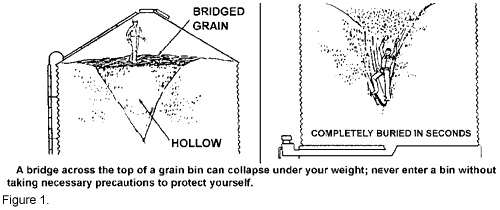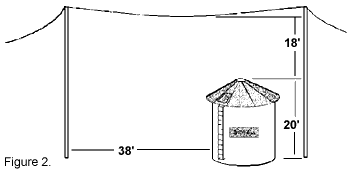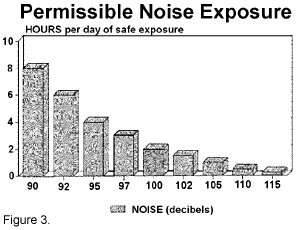Grain processing equipment and storage facilities may present a host of risks if a farmer fails to carefully look at the potential hazards in the workplace. These hazards include entanglement in augers, electrocution from contacting overhead powerlines, entrapment in flowing grain, respiratory illnesses from dust and molds, and other health and safety risks.
ENTRAPMENT

If possible, don't enter a grain bin -- break up crusted grain from the outside of the bin with a long pole. When using a pole, check to see that it doesn't come into contact with electric lines.
If you must enter the bin, as a farm owner/operator you should:
Safety Precautions
The Michigan Department of Labor Standards for Personal Protective Equipment requires employees to wear a safety belt or a safety harness and a lanyard affixed by a rope grab to a lifeline. All components must meet the state requirements. The Michigan Occupational Safety and Health Administration (MIOSHA) requires a lift tripod and harness lifeline arrangement for a rescue from the grain bin.
Remember that crusted grain may be covering voids or cavities that can trap and injure you, use caution and avoid entering grain bins if at all possible.
Employees are subject to Michigan's confined space regulations under the Michigan Department of Labor's safety and health laws. This publication addresses only farm owner/operator concerns related to on farm grain processing equipment and storage facilities.
ELECTROCUTION
To avoid the risk of contacting overhead lines, lower the auger before transporting and follow National Electrical Safety Code (NESC) recommendations of keeping all overhead electric lines a minimum of 18 feet above the highest port of the bin (see Figure 2) when portable grain augers are used.

DUST AND MOLDS
The type of dust and duration of exposure will determine the severity of the health problem. Some dusts, especially dust from moldy forage, grain, or hay, carry antigens that can cause severe irritation to the respiratory tract. Breathing dust from moldy feed materials can result in a permanent lung condition commonly known as "Farmer:s Lung".
Farmer:s Lung is one of the most disabling diseases among dairy farmers. Symptoms of Farmer:s Lung are easily mistaken for bronchitis or pneumonia and may not be noticed for several hours after exposure to the dust. Irreversible lung damage and sometimes death results when the disease is not diagnosed and treated in early stages. A long term implication of the disease is shortness of breath, which requires the farmer to take frequent rest periods and severely limits the amount of work that can be accomplish.
"Nuisance dust" is a term frequently applied to less noxious forms of dust that a farmer is commonly exposed to while performing field operations or working around livestock. Inhaling these less noxious dusts decreases lung capacity and also causes some people to be more susceptible to respiratory infections such as pneumonia. Prolonged inhalation of dusty air causes lungs to harden and become inelastic, significantly reducing their functional capacity. Smoking of tobacco products has been reported to hasten the damage.
Prevention To reduce the risk of respiratory problems from dusts, a farmer should store only dry grain and dry, well-cured forages and hay. Mold develops in moist or wet grain, forages, hay and many other moist or stale organic materials.
To reduce dust exposure, a farmer should keep animal areas as clean and dust-free as possible. Stale dust and feed accumulations attract and absorb moisture from the air in the barn, creating an environment for mold and other microorganisms to grow.
Safety Precautions
NOISE
 Grain drying and handling equipment may produce enough noise
to damage the hearing of an individual working in the area.
Grain drying and handling equipment may produce enough noise
to damage the hearing of an individual working in the area.
Typically, a dull, ringing sensation in your ears after a long day of working with noisy equipment is an indication that you have exceeded a sound level that can be comfortably tolerated. This ringing is frequently accompanied with a slight loss of hearing, where it may be difficult to hear faint sounds that could normally be detected. Overnight rest will generally restore complete hearing, but repeated, prolonged exposure to noises of this intensity will likely result in permanent hearing loss. As the intensity of the noise increases, the amount of exposure necessary to cause hearing damage decreases (see Figure 3). Loud noises that cause pain to the ear, such as a shotgun blast or extremely loud music, may cause hearing losses after a short exposure (for more information on hearing losses see the CMASH publication Avoiding Hearing Losses on the Farm).
To avoid hearing loss, a farmer should wear ear plugs or ear muffs whenever exposed to noisy equipment that causes any hearing loss symptoms. There are numerous types of plugs and muffs available in price ranges from a few cents to $20. Quality ear plugs and muffs have a noise reduction rating (NRR) which indicates how many decibels of noise they reduce. Ear plugs have an NRR ranging from 26 to 31, while ear muffs have an NRR of 23 or more. Choose whatever is most comfortable and provides the necessary protection for you.
CHILD SAFETY
Accident reports show that Michigan children have been killed or maimed in augers, or have suffocated in gravity wagons as the grain flows out and traps the child.
It takes a proactive approach to protect children. Simply telling the child to keep out of the area doesn't guarantee that a curious child won:t enter, it:s up to adults to make sure that the child is protected. This protection may require fencing the area off, cutting the legs off grain bin ladders so a child can:t reach the bottom rung, or whatever it takes on your particular farm. Don:t set yourself up for a lifelong nightmare, protect children from farm accidents.
REFERENCES
Michigan State University, Agricultural Engineering Department.
Howard J. Doss, Agricultural Safety Specialist; and William McLeod, Agricultural Engineering, Michigan State University Extension, East Lansing, Michigan 48824. 5/93. Funded by the National Institute of Occupational Safety and Health - #UO5/CC-4506052-02.
This information is for educational purposes only. Reference to commercial products or trade names does not imply endorsement by the MSU Extension or bias against those not mentioned.
Disclaimer and Reproduction Information: Information in NASD does not represent NIOSH policy. Information included in NASD appears by permission of the author and/or copyright holder. More